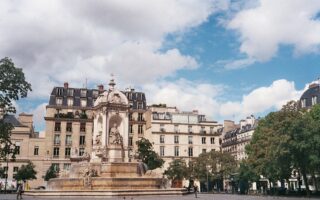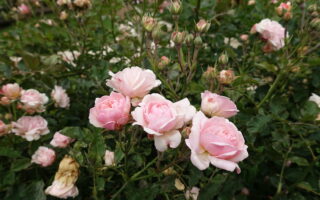Jardin Frederic Dard
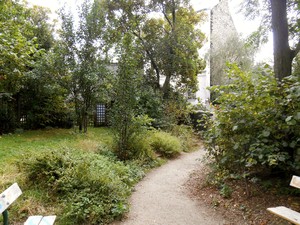
- SUBSCRIBE
- ALREADY SUBSCRIBED?
BECOME A BONJOUR PARIS MEMBER
Gain full access to our collection of over 5,000 articles and bring the City of Light into your life. Just 60 USD per year.
Find out why you should become a member here.
Sign in
Fill in your credentials below.

Eighteenth Arrondissement
Rue Norvins
Park Attributes: Near Metro, Water Fountain, Low Street Noise, Perfect for a Picnic
It is here that people pass through walls. Stone faces are carved into apartment buildings, peaking at the passers-by on the meandering cobblestone road called Rue Norvins. This park is hidden in the shadows of Sacre Coeur, just a few minutes walk downhill from the busy intersection of Rue Norvins and Rue des Saules. It’s on this cheery, colorful junction that you will find a myriad of souvenir stores and restaurants, tucked inside alleyways and along cobblestone passages that always seem to end at mammoth staircases that edge down the butte of Montmartre.
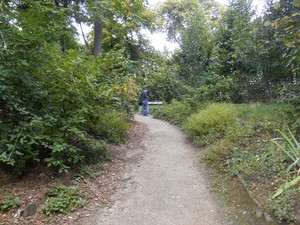 The best time to visit Jardin Frederic Dard is after lunch. Try a restaurant situated along the alleyways that spiral off Rue Norvins. The cobblestone passageways of Montmartre will take some time to get used to. The eighteenth arrondissement is still considered a village, a hamlet of eclectic apartments that have housed some of the finest artists of the nineteenth century. This was the home to Pissarro, van Gogh, Matisse, Satie, Renoir, Toulouse-Lautrec, and Picasso. It was here that Théophile Alexandre Steinlen painted his famous advertisement for the tour of Le Chat Noir cabaret. You will certainly see many reproductions of his painting, the tall black cat standing on a red ledge, scattered in storefronts, cafés, restaurants, boulangeries, apartment windows, and souvenir stores.
The best time to visit Jardin Frederic Dard is after lunch. Try a restaurant situated along the alleyways that spiral off Rue Norvins. The cobblestone passageways of Montmartre will take some time to get used to. The eighteenth arrondissement is still considered a village, a hamlet of eclectic apartments that have housed some of the finest artists of the nineteenth century. This was the home to Pissarro, van Gogh, Matisse, Satie, Renoir, Toulouse-Lautrec, and Picasso. It was here that Théophile Alexandre Steinlen painted his famous advertisement for the tour of Le Chat Noir cabaret. You will certainly see many reproductions of his painting, the tall black cat standing on a red ledge, scattered in storefronts, cafés, restaurants, boulangeries, apartment windows, and souvenir stores.
The entrance to Jardin Frederic Dard is at 26 Rue Norvins. It is hidden between a long stretch of unassuming grey-brick walls. Look for the black gate with the sign that says, “Jardin Frederic Dard,” written on a bright green sign. This place was named after the most famous French crime novelists in the second half of the twentieth century. The entrance to this park is a bit mysterious as well, possibly an homage to the park’s namesake. Walk into the lush landscape that twists between bushes and a variety of trees. The dirt pathway is in the shape of an Ω, leading you to a set of three wooden benches placed beneath high-arching trees and overgrown ivy that tangles over the wooden fences in the background. A water fountain is tucked under a drooping tree in the corner of the park, providing cool, clean drinking water that is much appreciated in the summer.
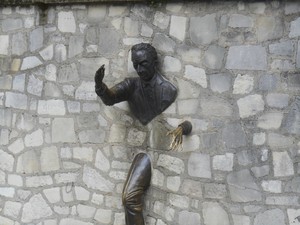 The pathway will meander downhill for a while, culminating at a handsome summer lawn, with soft green grass and thick trees to sit beneath for shade in the summer. From within the fortification of evergreen in Jardin Frederick Dard, you will not hear the cars on the adjacent streets, nor will you hear the footsteps of tourists on the heavily trafficked junctions further up the road. This park was built in 2010 for the locals of Montmartre, and you will see them, sitting quietly on the wooden benches, in the grass with their shoes off, reading a book, enjoying the tranquility, or just hanging out on the large tree trunk painted yellow, acting as a couch to sit on while enjoying the view below. Look down from the railing and you will see the metal statue of Marcel Aymé (the writer of The Man Who Could Run Through Walls) passing through a brick wall.
The pathway will meander downhill for a while, culminating at a handsome summer lawn, with soft green grass and thick trees to sit beneath for shade in the summer. From within the fortification of evergreen in Jardin Frederick Dard, you will not hear the cars on the adjacent streets, nor will you hear the footsteps of tourists on the heavily trafficked junctions further up the road. This park was built in 2010 for the locals of Montmartre, and you will see them, sitting quietly on the wooden benches, in the grass with their shoes off, reading a book, enjoying the tranquility, or just hanging out on the large tree trunk painted yellow, acting as a couch to sit on while enjoying the view below. Look down from the railing and you will see the metal statue of Marcel Aymé (the writer of The Man Who Could Run Through Walls) passing through a brick wall.
This was one of the first places that I visited while writing my book on the parks of Paris. It was a place that opened itself up to me, on a cold September day when I was feeling the effects of homesickness, hoping that the commitment to write a travel book on the parks of Paris is a fruitful decision. It was then, in mid-thought, while sitting on the lawn, that a dog ran up to me to say hello. His owner was playing a game of fetch with a fallen tree branch, and the dog felt my melancholy, my desire to feel part of the city, its people, to be accepted as a local in the city of light. I petted the dog and he curled up under my feet. I watched as his owner talked to a friend between the tree branches in the distance, exchanging pleasant remarks in a patch of sun that had broken through the clouds. The dog looked up at me, licked his nose, then ran off towards his owner, returning the tree branch at his owner’s feet. The sun had warmed the park considerably, and so I got up and walked on the dirt pathway towards the entrance of the park, ready for a warm espresso at the top of the Montmartre.
Gregory Ross is the author of the Hidden Parks of Paris 2014, the first-ever travel book on the parks of Paris. It is available worldwide June 2014. He currently lives in Honolulu.
Lead photo credit : Jardin Frederic Dard
More in Jardin Frederic Dard, Paris parks, park
